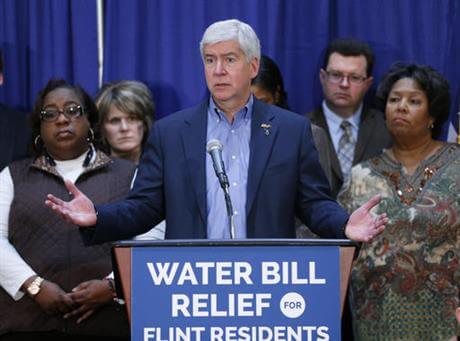
When it comes to water, only about half of Americans are very confident in the safety of what’s flowing from their tap, according to an Associated Press-GfK poll, which found that trust is even weaker among minorities and people with lower incomes.
The lead-contaminated water in Flint, Michigan, has been in the headlines for months, and more than half of Americans believe it’s a sign of widespread problems in the U.S. About seven in 10 drink tap water, but about half of them first run it through a filter.
“Of all the water systems in the nation, Flint can’t be the only one that’s faulty,” said Elsbeth Jayne, 28, of Christiansburg, Virginia, who’s very comfortable with her own tap water.
Joseph Johnson, 46, of Brooklyn, New York, said he only drinks bottled water, spending about $8 a month on two cases. He’s among the 30 percent of Americans choosing water off the shelf.
Sponsored Links
Top 3 Cards For Those Of Us With Less Than Perfect Credit
LendingTree
QUIZ: Can You Pass This Basic History Quiz?
Topix Offbeat
“I’ve always been under the assumption that water wasn’t 100 percent clean. The Flint situation brought more of the story to the surface,” he said Friday.
Flint, with a population of about 100,000, was drawing water from the Flint River for 18 months as a way to save money until a new pipeline to Lake Huron was ready. But the corrosive water leached lead from the city’s old plumbing because certain treatments weren’t added. Michigan Gov. Rick Snyder, whose administration repeatedly downplayed the lead threat, now calls it a “disaster.”
No level of lead in the human body is considered safe, especially in children. The river water also may have been a source of Legionnaires’ disease, which killed at least nine people in the region.
The poll found only 47 percent of Americans say they’re extremely or very confident about the safety of their drinking water, while 33 percent say they’re moderately confident and 18 percent are not very confident or not at all.
Forty percent of African-Americans polled and 28 percent of Hispanics were less likely than whites — 54 percent — to be very confident in their water’s safety. Less than 40 percent of households making less than $50,000 are very confident.
“The perceptions are realities,” said Marc Edwards, a water expert at Virginia Tech who played a vital role in documenting the lead problem in Flint. “Generally, tap water in the United States is safe. Problems that surfaced in Flint, including Legionella and lead, disproportionately affect poor minority communities.”
He said the problems are partly due to the “abysmal state” of old pipes in neighborhoods and homes across the country. You can click this for the best plumbing service.
Half of Americans say the federal government should do more to ensure safe drinking water, while 40 percent said the government’s role is about right. A regional director of the U.S. Environmental Protection Agency, who was criticized for not helping Flint sooner, resigned in January.
More than 60 percent of blacks and Hispanics say the federal government should do more, compared to 44 percent of whites, the poll found. Nearly 60 percent of households making less than $50,000 want the government to do more. Only 40 percent of households making more than $100,000 had a similar view.
Karl Bantom wants the government to be active. He said he and his wife have been using bottled water for years in their Philadelphia apartment.
“When I turn my water on, I get a sulfur smell. I’m not drinking this,” Bantom, 55, said. “They should test the water more thoroughly.”
When told about the poll results, a spokesman for the American Water Works Association, which represents water professionals, said the “vast majority” of water utilities in the country surpass federal and state standards.
“If people question the safety of their water, I’d encourage them to be in contact with their utility personally and ask the hard questions,” Greg Kail said. “Examine your utility’s water quality report. Talk to public health professionals. Get the answers you need. And then make an informed decision.”
The AP-GfK Poll of 1,033 adults was conducted online from Feb. 11-15, using a sample drawn from GfK’s probability-based KnowledgePanel, which is designed to be representative of the U.S. population. The margin of sampling error for all respondents is plus or minus 3.4 percentage points.
___
Swanson reported from Washington, D.C. Follow Ed White at http://twitter.com/edwhiteap
___



